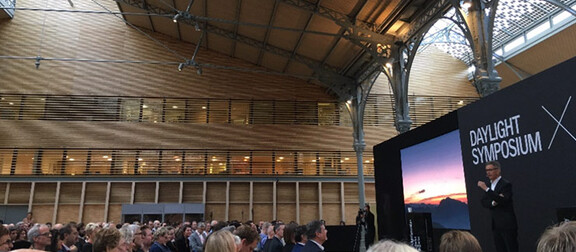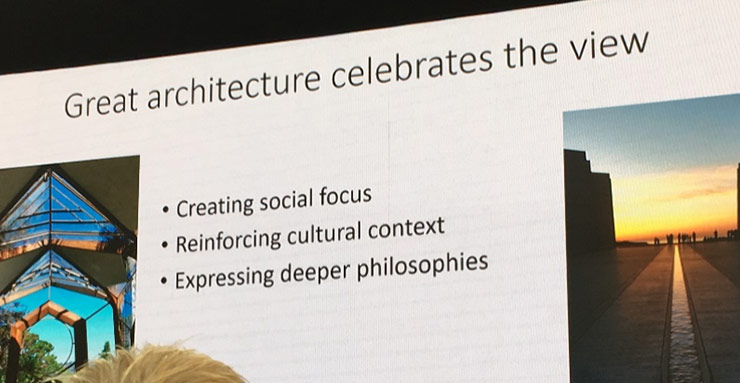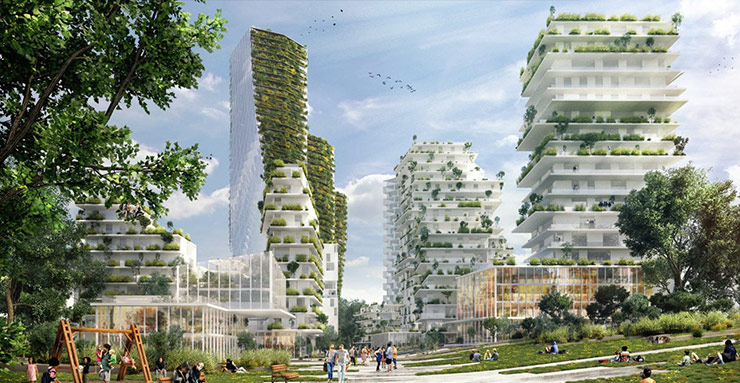8th Velux Daylight Symposium: a renewed interest in views and nature to shape sustainable architecture

Last month I had the chance to attend the 8th Velux Daylight Symposium, held in the magnificent 19th century’s medieval enclosure Le Carreau du Temple in Paris. This symposium, organized every 2 years, gathers designers, researchers, builders and occupants , from over the world to share insights on how daylight can contribute towards improving people’s lives.. This is really “THE” event that you don’t want to miss if daylight, comfort, health and sustainability are part of your job’s DNA.
Once again, I was thrilled by the quality of the speakers and their interventions: from leading practitioners playing elegantly with natural light to leading researchers exploring further the multiple branches of science, all with the same ambition to create better buildings respectful of both nature and people. While I can’t share here all the learnings of that day, there were two theme that really resonated with me.
A rising attention to windows’ views
In several of the presentations, window’s views came back as a main criteria of a space quality, as well as a key factor for people’s well-being and performance, starting with the morning plenary session by the renowned Lisa Heschong1. “Windows’ views are probably the most taken for granted but the least understood”, she introduced. A sentence that echoed so deeply in me! We all wish we could have large windows with nice views whether at the office or at home. We are even ready to pay a 5.9% premium price according to a recent MIT study which by the way was the topic of another talk of the plenary session. But only a few of us are aware that views can actually improve our cognitive capacities and our health, which is what L. Heschong shed a light on. As an illustration, she chose to point out two very interesting findings from research:
- Views may play a role in the function of our circadian rhythms
So far, the regulation of our body’s internal clock and circadian rhythms has been known to be dependent on factors like spectrum, intensity, duration, timing and past history of light exposure etc. However, research has found that there may be a correlation between what we look at and the potential for stimulating the circadian system. In other words, views may be even more important than daylight itself for enhancing sleep quality, alertness, mood etc.
- Views are good for “mind-wandering”
A Harvard study showed that US workers spend half of their waking hours mind-wandering, i.e. daydreaming. While long considered as being detrimental to the productivity of workers, recent research in neuroscience has revealed that this may be positive to boost our cognitive performance, such as working memory or creative problem solving. And having the possibility to look outside through the window is what would allow our mind to escape and solve problems “behind the scenes”. This rang a bell: would mind-wandering be part of the complex mechanisms described within the attention restoration theory? Or are we talking of another different and novel concept? We will certainly have the occasion to address this question in future articles.

“We need to bring view and preservation of view into architecture”, concluded Lisa Heschong
Given such fascinating findings, no wonder that windows’ views were at the core of other various on-going research studies presented during the afternoon’s session, such as new metrics to quantify the view out (Aarhus University, Denmark), models to predict what attracts people’s visual attention (EPFL, Switzerland), methodologies to assess views dynamically (Queensland University of Technology, Australia).It was also interesting to see that the amount of view was systematically considered during the evaluation of people’ spatial experience, in the frame of window size or façade geometry optimization (University of Science and Technology, Norway; EPFL, Switzerland).
While there is already in the literature a large set of evidence on the benefits of a visual connection to the outdoors on physiological and mental health, there are still some gaps to fill in that open new interesting areas of research. However, it seems that even the existing knowledge has not been leveraged yet. This demonstrates the importance to continue to share, and to educate, so that we eventually all recognize the true value of views when designing buildings for people.
Daylight and Nature as a response to Climate change and Resilience
In comparison to the previous Berlin’s symposium, I felt like this time it was not just about discussing why and how to bring daylight to create more comfortable and healthier buildings. It was much broader than that, raising the question of “how can we change the way we conceive our buildings and our cities to respond to the challenges of growing urbanization, natural resources depletion and climate change?”.
Several examples of inspiring visions and projects were shared, where daylight and nature would be integrated in buildings and districts to help cleaning the air and water, maintaining biodiversity, relieving people from mental health problems (SLA Architects, Chartier-Dalix Architects). Then combined with low-carbon materials, one could create a path to climate neutrality and long-term resilience, and eventually to buildings capable of “regenerating” the environment (A2M Architects).

Nature is at the core of the Paris-Charenton project, Reinventing Paris Metropol competition (Source: A2M Architects)
While those concepts may seem futuristic, they actually reflect the needs of today’s investors and users, and it is very likely that they will inspire the future regulations.
In a nutshell, when thinking our built environment, greater integration of daylight, views and nature have a great role to play to “achieve a better and more sustainable future for all”2. On the other hand, collaboration, dialogue, as well as larger dissemination of knowledge is also crucial, and that’s precisely what such type of event aims for.
- Lisa Heschong has led many research field studies on the impacts of daylight and views in schools, retail and offices within the Heschong Mahone Group (HMG). She was also highly involved in the development of climate-based daylight metrics and their implementation into certifications and codes in the U.S. She is also the author of Thermal Delight in Architecture, which addresses the role of alliesthesia in building design.
- https://sustainabledevelopment.un.org